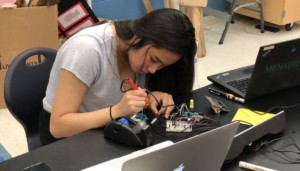8 Online Learning Trends that are Changing the Learning Landscape

Seeking access to more and better learning opportunities, a state official called and asked about next generation K-12 online learning. Despite recent headlines, we’ve seen online learning make a big impact in K-12. And we see eight trends–some emerging from K-12 providers, some from HigherEd–improving the opportunity to learn online.
- Broader aims. Like place-based education, online learning is beginning to embrace a broader set of outcomes including success skills and global citizenship.
- Connections Education curriculum helps develop the 4C’s: Critical thinking and problem solving, Communication, Creativity and innovation, and Collaboration.
- Global Personalized Academics (Julie Young’s new venture) offers a personalized student-centered online dual degree program for international students that includes leadership and entrepreneurial learning experiences, college counseling, career exploration and English as a Second Language. “We believe the leaders and entrepreneurs of tomorrow must become global citizens today, which is why we’re trying to create opportunities for students all over the world to exchange ideas with peers from other cultures,” says Young.
- More project-based learning. Like traditional schools, we’re seeing more focus on student engagement particularly project-based learning.
- Projects are spine of the Idaho Distance Education Academy curriculum. There is a mixture of individual and team-based projects. With the goal of helping students appreciate the value of what they are learning, projects are rigorous and relevant. Students collaborate through technology to provide peer feedback to one another on projects–and it is part of their grade (see feature).
- College for America, a division of online learning giant Southern New Hampshire University, has an innovative project-based curriculum that helps working adults develop and demonstrate 120 competencies (see feature). Big Picture schools are piloting the College for America projects for college credit in high school.
- More personalized learning: Providers are using data to personalize learning experiences and sequences for each student.
- In many K12 schools, teachers are talking about data on student academic performance—not just talking but analyzing the data and, based on their insights, changing the way they teach. It’s all part of an effort to improve student academic achievement by implementing the principles of Data Driven Instruction.
- Connections Education Math Teachlets in Algebra and Geometry are instructional modules that supplement the asynchronous model and help students understand challenging topics by presenting them in fresh and engaging ways (winner of the 2012 Tech & Learning Awards of Excellence). LiveLessons provide synchronous support which helps to further personalize the instruction based on individual student’s needs.
- Some learning sequences will incorporate game-based and adaptive learning strategies.
- More interactive: “Engagement is even more important than in a traditional model — lack of engagement is directly related to lack of achievement,” according to a Digital Learning Now report.
- Research affirms the importance of engaged and approachable instructors in online education.
- Connections Education State Signature Courses: Interactive state-specific history courses for grades 2-4 in Georgia, Louisiana, Oklahoma, and Utah; they feature an inquiry-based approach, virtual timelines, Google Earth tours, and interactive presentations (winner of the 2012 Tech & Learning Awards of Excellence).
- K12 is getting mobile friendly with the launch of an updated course catalog with over 90 tablet ready courses that will allow even more students to learn anytime, anywhere.
- Corporate trainers suggest micro-interactions (of less than five minutes), challenges, game-based strategies, and frequent feedback.
- Some courses will incorporate augmented and virtual reality.
- More support: Quality programs offer strong online and on site support.
- Connections Education has improved its onboarding particularly for late enrollers (who, not surprisingly, complete and achieve at lower levels on average). Students are connected to a Learning Coach for training sessions and support services.
- Georgia Cyber Academy improved onboarding and wrap-around services and demonstrated significantly greater gains than similar students who did not receive these services.
- Hoosier Virtual’s administrators spend more time observing teachers and working with them in data meetings to focus on improving student outcomes. Administrators are also working to provide teachers with streamlined data reporting and data driven instruction-related professional development. Academic Administrator Patricia Herron says that “Hoosier has become a very positive environment. Teachers are ‘owning’ student data and their decisions.”
- K12 combining data science and increased school support staff and piloted a differentiated start of school on-boarding program at 17 schools this fall.
- For full-time online students leading operators are expanding college and career planning services (more on virtual CTE soon).
- Stronger relationships: In Smart Cities we noted that “Learning, especially for children, is and will remain a distinctly relationship-based enterprise.” Quality online learning providers recognize that teacher and advisor relationships are key.
- The success of Wisconsin Virtual Academy is based on powerful relationships. Head of School, Dr. Leslye Moraski Erickson values strong collaboration and teamwork, she actively recruits and hires teachers she describes as “collaborative in spirit.”
- Relationship tools, like Fidelis, are helping providers monitor academic progress, scheduling, career and college guidance, and challenges that require links to youth/family services.
- More competency-based: Most high school and college learning will continue to be organized as courses with end of course exams or demonstrations. WGU, the largest provider of math and science teachers, features a rich course of study including ebundles, home-delivered labs, digital simulations. The program relies heavily on end of course exams as competency-based gateways.
- TEACH-NOW from the Educatore School of Education is an example of innovative, learn by doing, online teacher prep and certification program that provides an interactive collaborative and efficient certification option for next-gen educators. Learning modules are mapped to specific competencies.
- College for America (discussed in #2) replaces courses with a sequence of projects that support individual progress. Big Picture high schools in Providence use the CfA projects for dual enrollment.
- More part-time: Full-time enrollment in virtual schools will continue to grow slowly but part- time online learning that supplements a blended core will continue to grow rapidly. Course Access describes state policies that allow K-12 students to access a variety of quality courses outside the school where they remain enrolled. This policy strengthens the traditional classroom and school, and allows students to an expanded and targeted course catalog.
- Through a partnership with Florida Virtual School and Fuel Education, Miami Dade County School District created Blended Learning Communities (BLC), computer labs where students can take at least one online course.
- Credit recovery: Fulfilling a credit for a dropped or failed course–is a common application of part time online learning
To support more high quality next-gen online learning, states should adopt:
- Portable and performance-based funding;
- Better growth measures of individual student progress;
- Quality provisioning and authorizing of online providers.
For more on College for America see
- Big Picture Learning Pilots Dual Enrollment with College for America
- Southern New Hampshire Reshaping Higher Ed Landscape
- Match Beyond And College For America Reimagine HigherEd
Stay in-the-know with all things EdTech and innovations in learning by signing up to receive the weekly Smart Update.






0 Comments
Leave a Comment
Your email address will not be published. All fields are required.